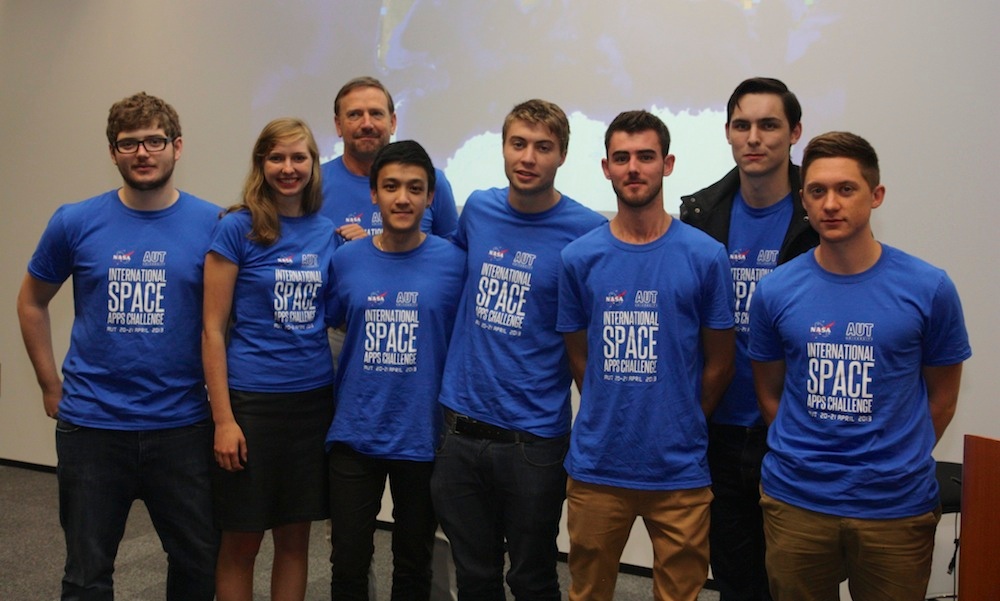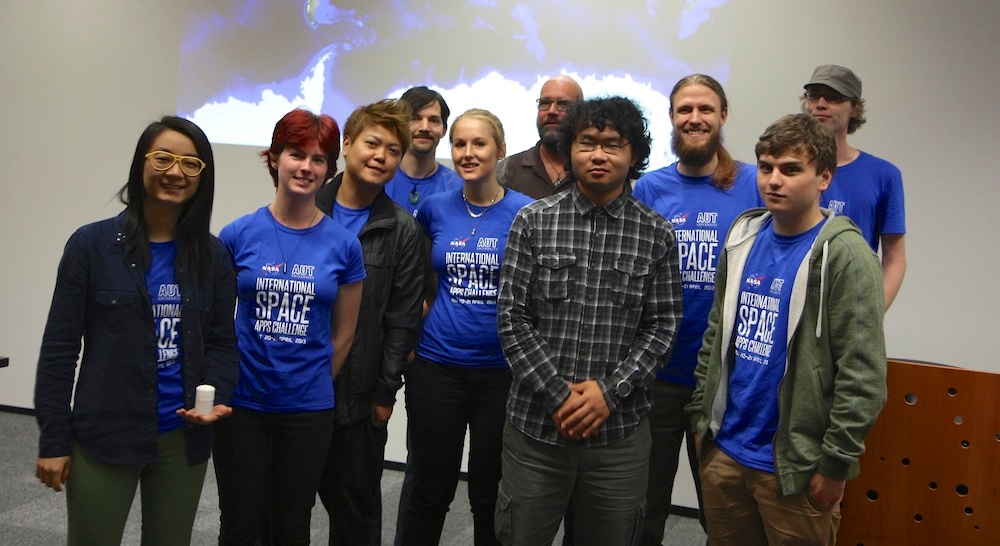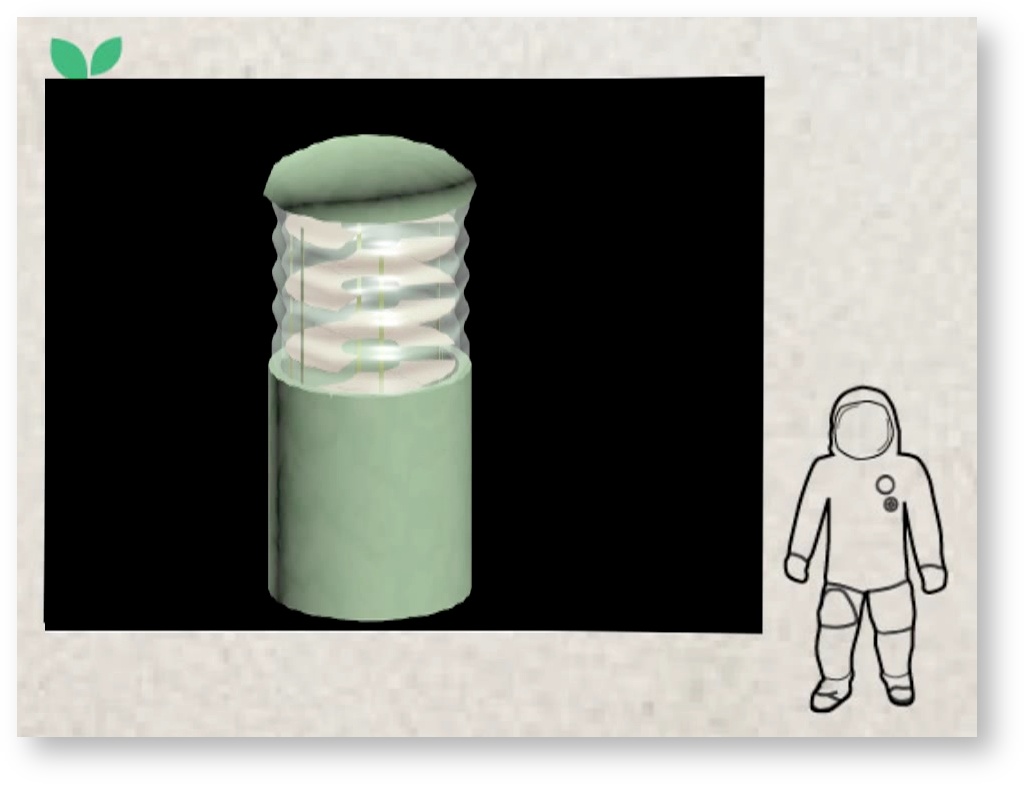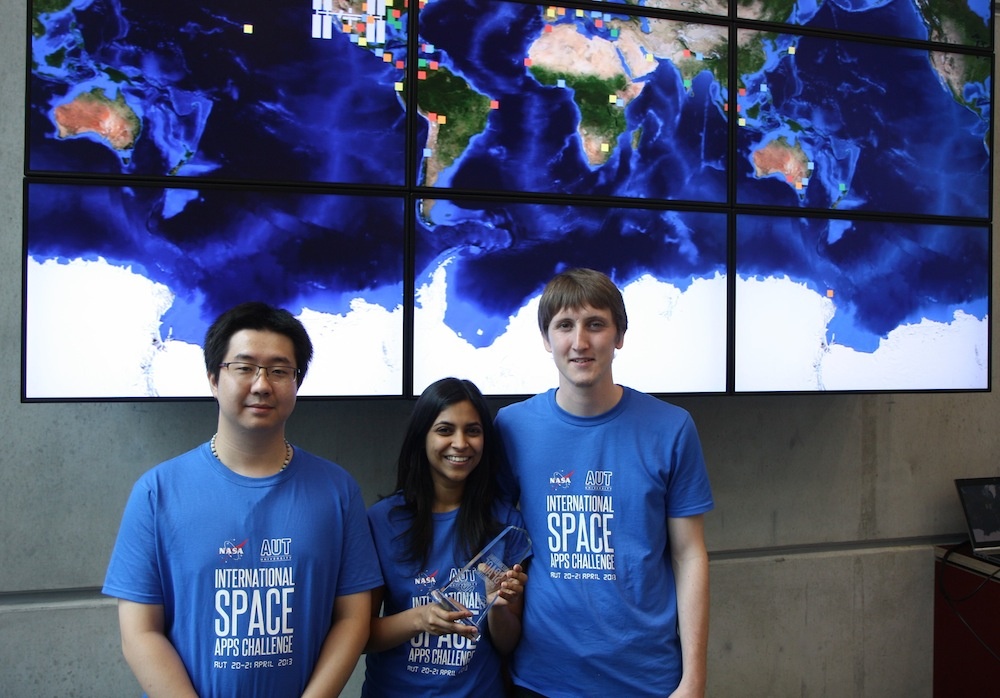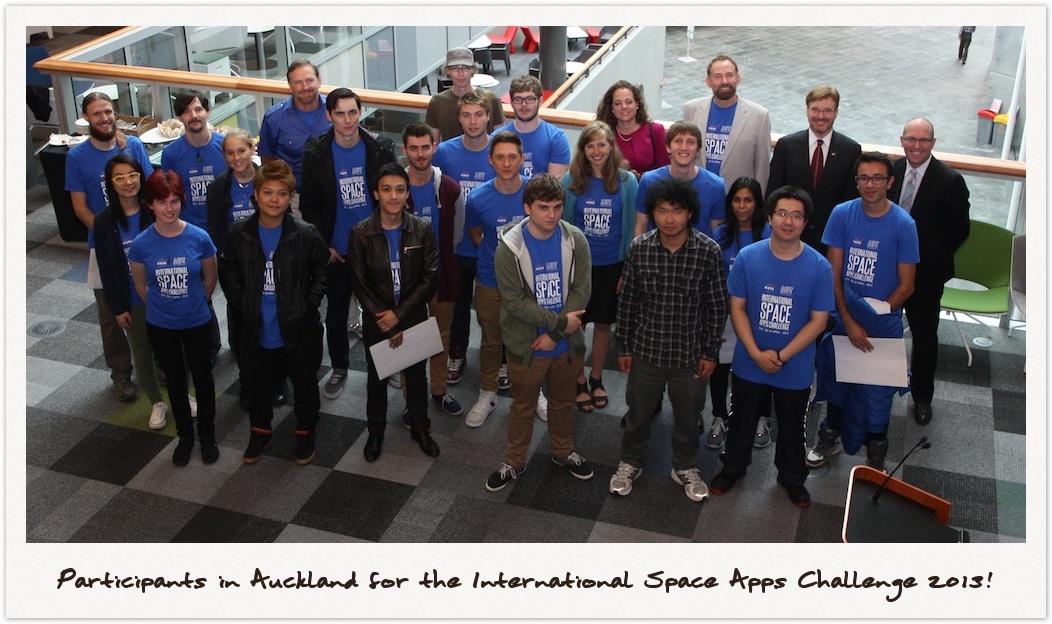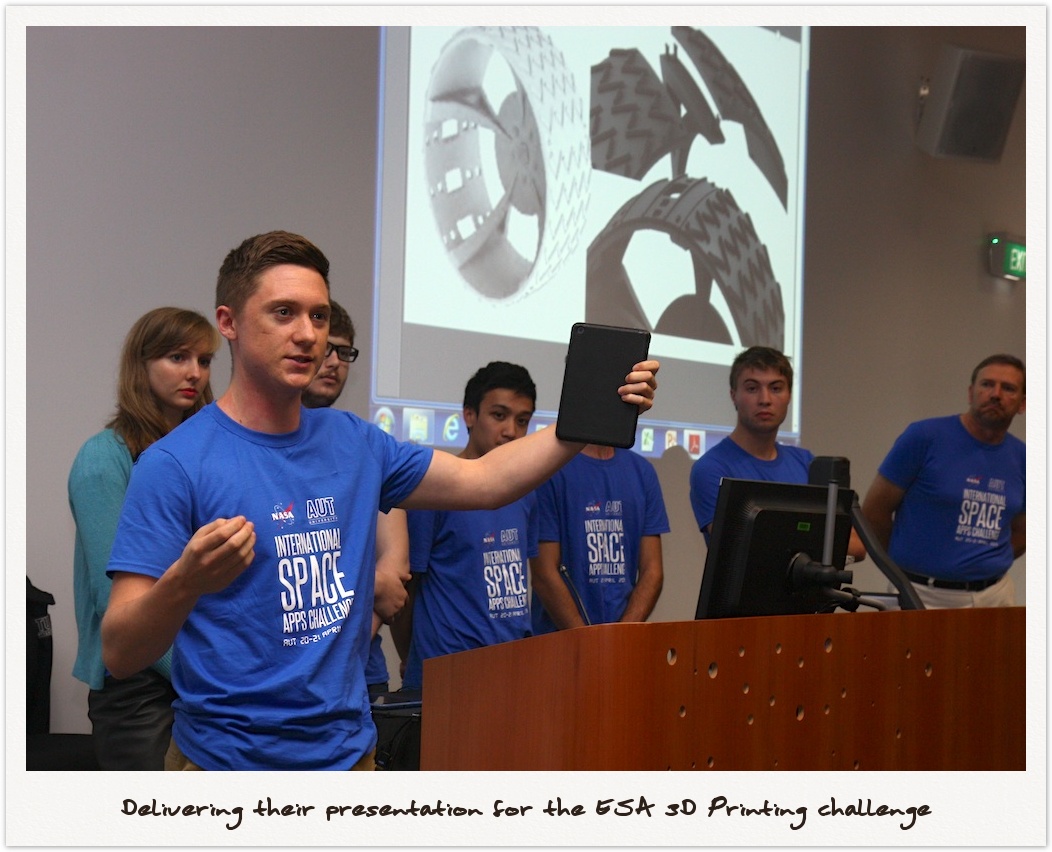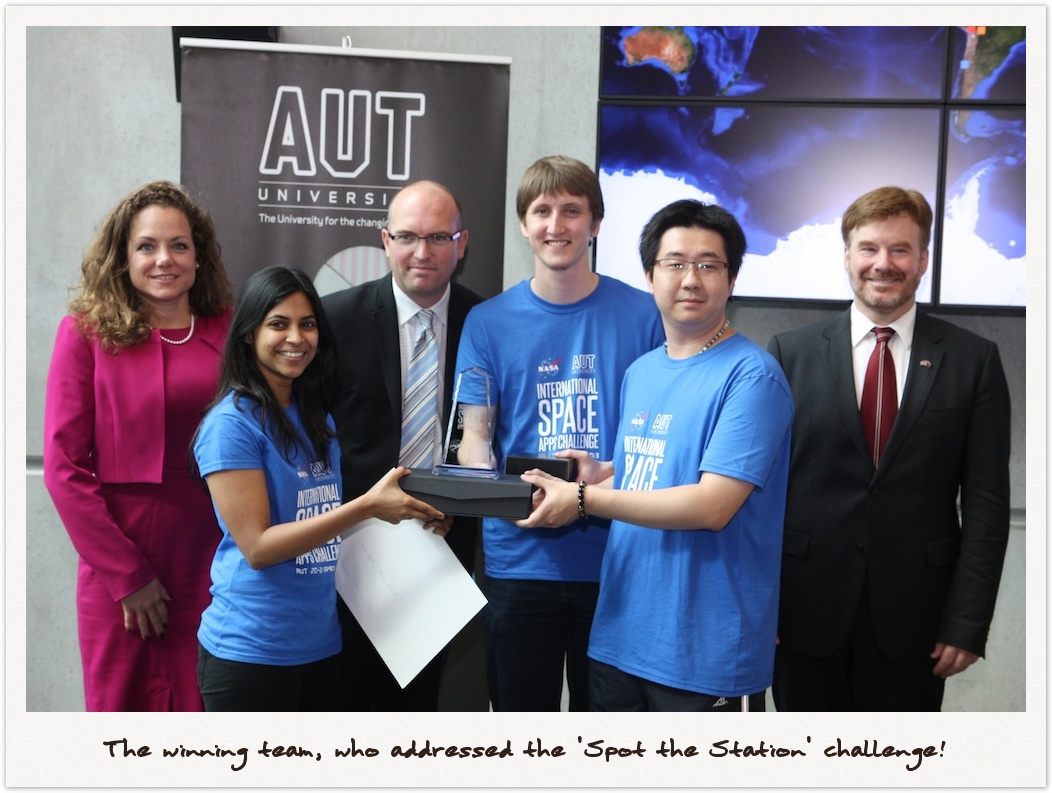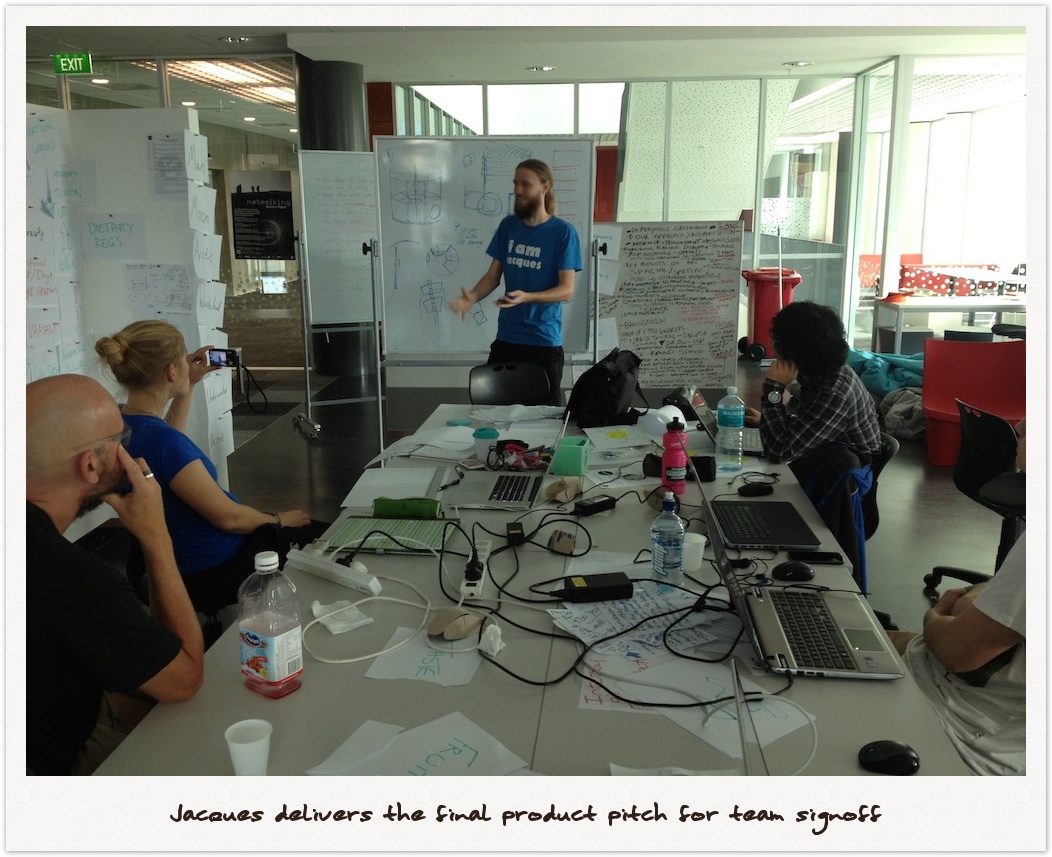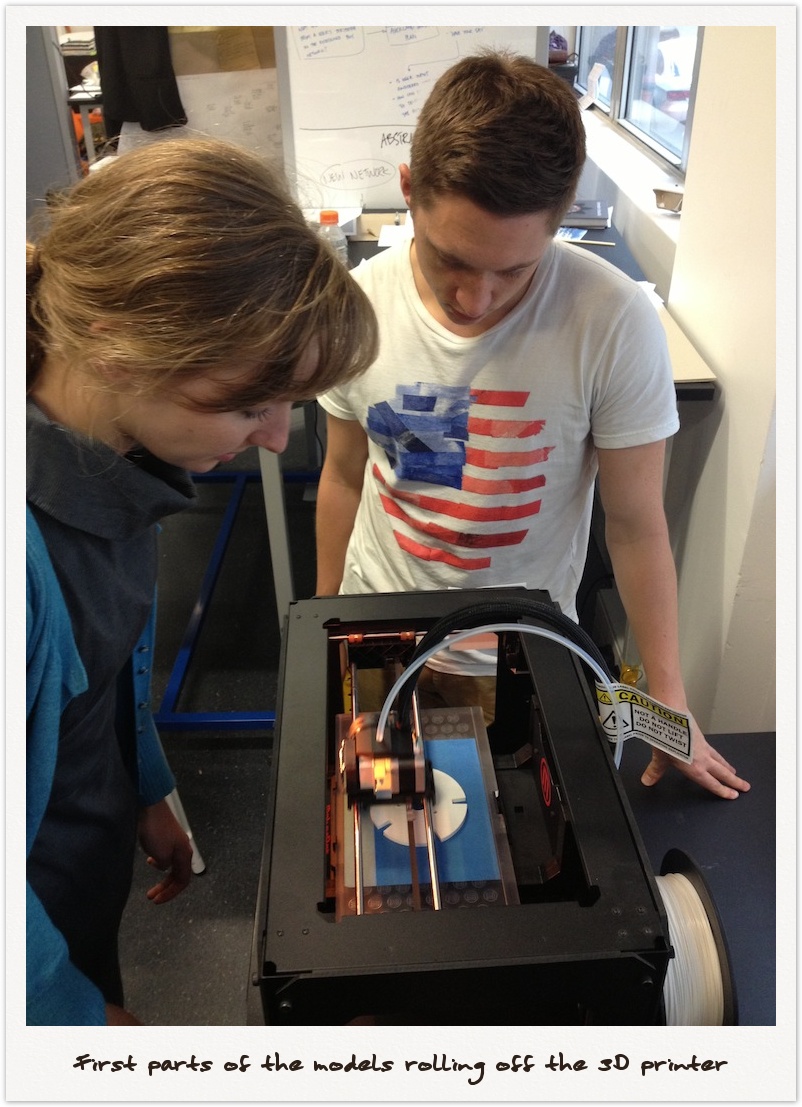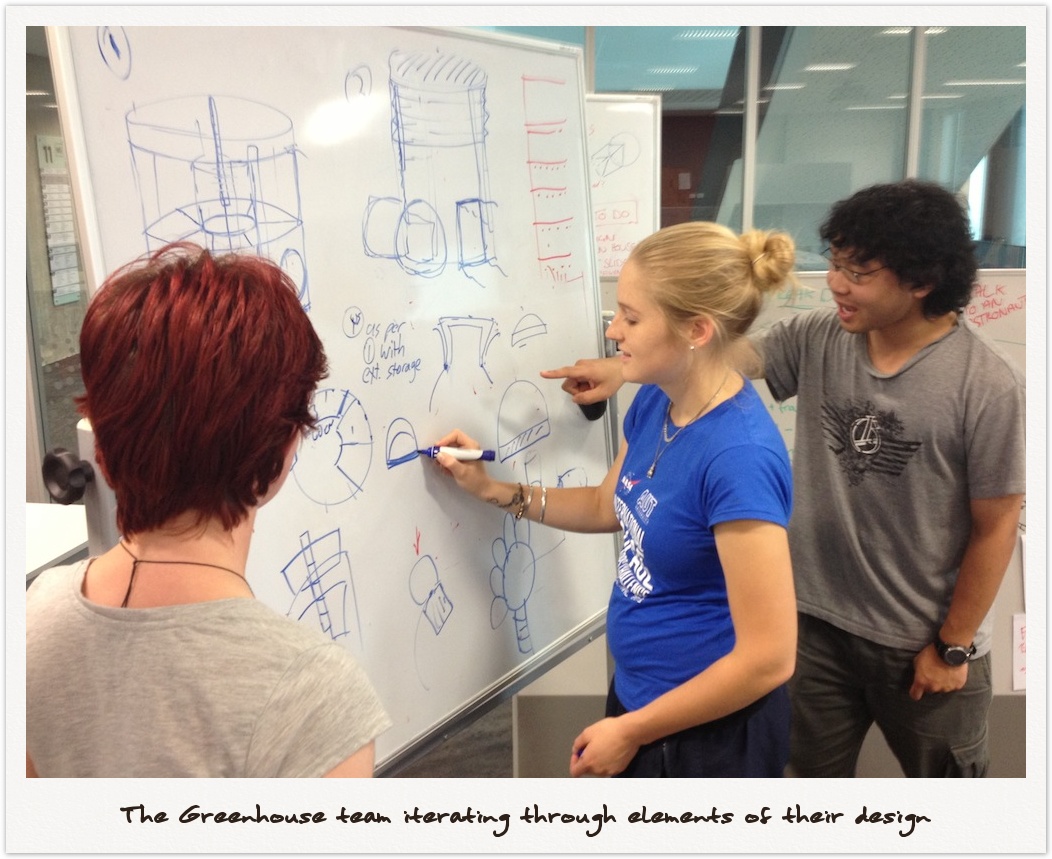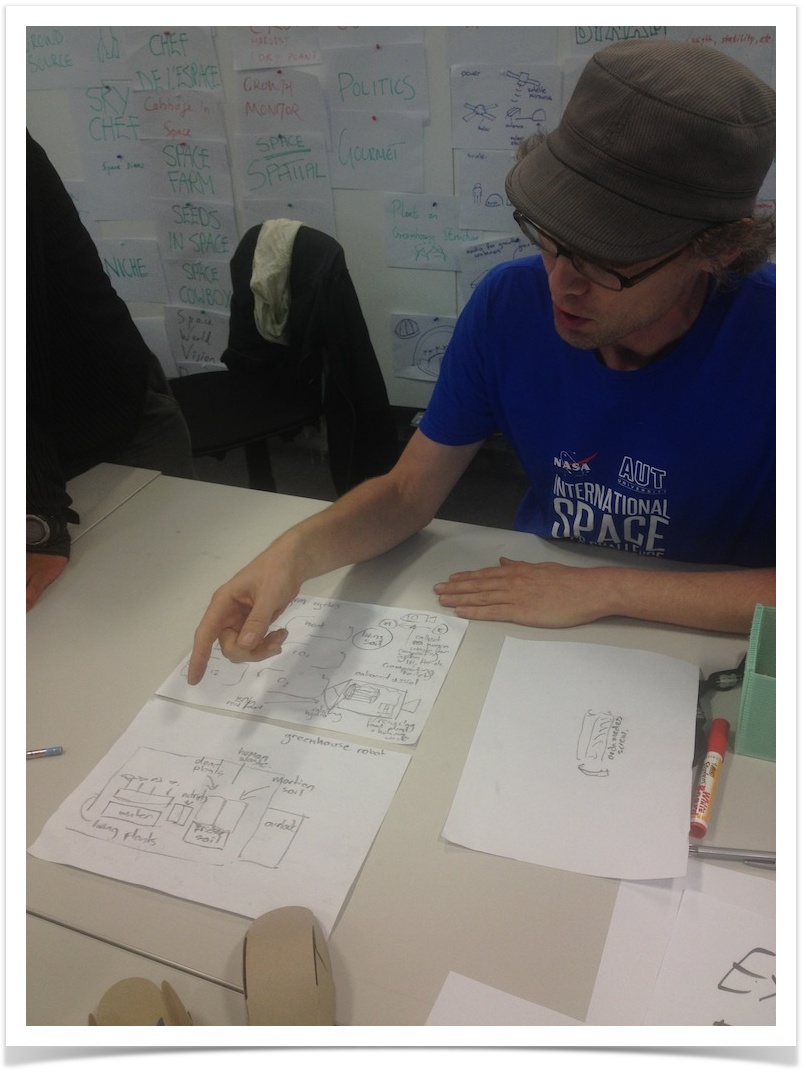| Challenge | For the Record |
|---|---|
| Team Project Page | ZenSpace |
| Auckland Placing | #4 |
Placing fourth in the Auckland judging for the International Space Apps Challenge, was team "ZenSpace"
The challenge they addressed, was "For the Record" – a way to allow participants in NASA programmes to provide feedback on how they're feeling during the program, etc.
Project Presentation
Judges Comments
Commentary
The final presentation only shows part of the story, and missed the blood sweat and tears behind the scenes. I spent the weekend jumping around and talking to the teams, so here are some additional comments and thoughts which you may find useful:
- There were two people in the team - Faizev & James - and I believe both of them worked virtually, at different locations.
- They initially started on the challenge Comparing Earth Landscapes but ended up changing their mind and switching to For the Record. So like the others, they suffered from a lack of time to produce the final product
- As the judges mentioned, they had a less 'sexy' project to work on, making it a tougher sell in the presentation. But they came up with some nice aspects, such as the word-cloud visualisation.
- With an app like this, a lot of the work is hidden behind the scenes – server infrastructure, backend logic, etc – so given they only spend say 12-18 hours on it they did extremely well.
| Challenge | ESA 3D Printing Contest |
|---|---|
| Team Project Page | Space Cadets |
| Auckland Placing | #2 |
Placing second in the Auckland judging for the International Space Apps Challenge, was team "Space Cadets".
Their challenge was to produce a 3D printing design, relating to an aspect of an European Space Agency mission.
Project Presentation
Judges Comments
Commentary
The final presentation only shows part of the story, and missed the blood sweat and tears behind the scenes. I spent the weekend jumping around and talking to the teams, so here are some additional comments and thoughts which you may find useful:
- The team had some difficulty reconciling the brief, especially given they didn't feel they were likely to come up with the most intricate 3D model capable of winning the challenge on engineering prowess alone. They were also not very familiar with ESA's space missions.
- So similarly to Team Captain Cook, they tried to play to their strengths around design thinking – and approach the challenge from a more unique angle.
- The team struggled a bit to decide on a solid direction though. For them, 3D printing was useful for solving the unpredictable – and so coming up with a relevant 3D model was difficult ('how do you model the unknown?').
- They also focussed on the human aspects of spaceflight – and trying to let astronauts on a mission, separated from the 'real world', connect in a more tangible way with people back home. They imagined a child of an astronaut scanning and transmitting up their latest classroom creation - e.g. a slightly wonky clay coffee mug. While impractical to drink from in space, fathers on Earth get to see and touch that visual reminder of their child's effort.
- Like others with a relatively broad brief, they too struggled to decide on a firm direction until mid-Sunday. Surprisingly this cost them most in the presentation aspect, rather than the physical modelling. The wheel they produced in the end was quite visually impressive (and quickly turned out), and definitely swayed the judges. However their presentation message was quite hard to extract – and left the judges quite bewildered. I suspect they would have benefited by sticking to one or two points only, and importantly, ensuring one of these related to the wheel they modelled...
- This was the first time I'd seen 3D printing in person, and it definitely is very cool - when 3D printers to end up on the space station, and in classrooms – I can really imagine some very tangible, tactile interactions occurring.
| Challenge | Deployable Greenhouse |
|---|---|
| Team Project Page | Captain Cook |
| Auckland Placing | #3 |
Placing third in the Auckland judging for the International Space Apps Challenge, was team "Captain Cook".
Their challenge tasked them to design a greenhouse suitable for pre-deployment on placed like the Moon and Mars. The team didn't have a biology or engineering background, so in tackling this task they took a different approach – with a focus on the humanisation of gardening on other planets, rather than trying to design the most-efficient greenhouse.
At a high level, they proposed the following:
- Build a greenhouse that uses a physical volume similar in shape to proposed human habitats from popular renders by SpaceX, NASA, etc. (e.g. this picture)
- A focus on manual tending of the plants, rather than automated systems - providing therapeutic benefits for the astronauts
- Cafe culture – thinking of the greenhouse as a place of relaxation: read a book surrounded by your plants, etc.
- Basic engineering designs, which provided for storage space, re-use of internal systems for things such as seats for astronauts, etc.
Project Presentation
Judges Comments
Commentary
The final presentation only shows part of the story, and missed the blood sweat and tears behind the scenes. I spent the weekend jumping around and talking to the teams, so here are some additional comments and thoughts which you may find useful:
- The team had a fairly broad and flexible brief, with quite a bit of engineering and technical requirements – but unfortunately no specific team members with these skills. As a result, they took much more of a high-level approach to the challenge (as opposed to say optimising oxygen exchange).
- The team split into two sub-groups – one with a presentation focus, and the other greenhouse design. Their early focus on the presentation is obvious when you compare the final presentation from the groups.
- However they spent almost the first 30 hours brainstorming through various ideas and design elements, but had difficulty settling on a final design.
- Once given some external support and a possible framework to test the practicality of their ideas against – they quickly worked through and sketched out a final design, allowing the 3D modelling to begin and concrete work on the presentation.
- This delay in deciding on the high-level design however meant some of the extra detail and unique design elements they'd brainstormed, were glossed over or missed in the presentation, and in my opinion, this ultimately cost them in the judging.
- The 3D model and animation was great - but they needed a little more time – being able to show the greenhouse layout in each of the various states, with exploded views/etc, would have really helped
- They also had done a brief Skype and Google Hangout with the challenge organiser, who had emphasised the importance of a number of the human-elements of the greenhouse – but unfortunately they didn't communicate this to the judges. This, combined with the absence of more examples of subsystem detail ultimately cost them.
- Here are a few of the features they came up with, but didn't really convey in the presentation:
- The ability for astronauts to come in and service plants and adjust the inter-rack height to suit different crops
- Astronauts could effectively have their own rack of plants – their own 'garden' – and the sense of ownership and pride that goes along with this
- The flight/transit configuration was quite efficient and allowed for a lot of additional storage. Seeds would initially be sitting ready and inactive in their growth medium, with their racks tightly stacked in the top-portion of the greenhouse, leaving lots of space below for priming resources such as water, seeds, gasses, and potentially storage for other base components.
- Some good work was put into thinking how habitat deployment would occur - such as using the lower pressure outside to transfer internally stored water into expandable bags on the outer side.
- Any necessary machinery, gas storage, etc could be contained in a low cabinet that could double as a couch and workbench - giving somewhere the astronauts could sit and relax while sitting on, with their plants lowered down nearby. Bring a book and take some time out...
- Potential use of the expanded greenhouse volume during the day for other activities – possibly as a kitchen.
| Challenge | Spot the Station |
|---|---|
| Team Project Page | Spot the Station AUT |
| Auckland Placing | #1 |
Placing first in the Auckland judging for the International Space Apps Challenge, was team "Spot the Station AUT" - consisting of:
- Wayne Cen (left)
- Eleanor Da Fonseca (centre)
- Boris Feron (right)
- Harrison Black (not pictured)
Their winning project consisted of an android application that included:
- Real-time tracking on a map of the ISS' current location
- Alerting via push-notifications when the station is approaching your location
- Sharing via social media that you've seen the ISS, and optionally a photograph of your sighting or some aspect of your experience
- Indications of other sightings in your vicinity, to promote the social-nature of such an experience
- Directional indications of where to find the ISS, overlaid on a real-time view from the camera
Project Presentation
Judges Comments
Commentary
The final presentation only shows part of the story, and missed the blood sweat and tears behind the scenes. I spent the weekend jumping around and talking to the teams, so here are some additional comments and thoughts which you may find useful:
- The team benefited greatly from the fact that their challenge was a more defined brief – which allowed them to hit the ground running right away (other teams didn't really start until Sunday).
- With all software projects though, it's sometimes the simplest things (like a typo, or misunderstanding on how to use a library or API) that can slow you down – and so they still had their fair share of problems to overcome.
- Eleanor during Q&A said that they had various things going 'by Saturday'. But I'm pretty sure she meant by the end of Saturday – as opposed to them having done full preparatory work. From speaking to the team myself, I think the pre-weekend focus was on setting up the server and doing the necessary Google pre-registration work to get the push-notification framework functional. Nevertheless, they certainly had done more preparation and planning than the other three teams.
- However I do wish they'd put a bit more thought early-on into how such an application would be used, and what the general public would be looking for in the application. As demonstrated, I feel the app was a bit too much like a 'collection of features' – It lacked instructions and other aspects to make it a 'usable' app. Time of course was their enemy here - so hopefully as they continue on with the project post-competition that they'll address these issues. This was after all a 'hackathon'
- Given they'd never even tried to see the space station before, and I believe were playing with technologies and integrations that were new to them – I think they did very well.
Congratulations to all teams in this year's International Space Apps Challenge! The Auckland event came to a close this morning (Mon 22 April) with team presentations and prizegiving. So who won? Read on!
The perfect opening act
By pure coincidence, at around 9am this morning NZ-time, Orbital Sciences was providing their exhilarating contribution to the Challenge programme – with the maiden launch of their Antares Rocket (a private rocket being built for NASA's commercial cargo program). If you haven't already seen it – you can watch it below:
I couldn't have imagined a more perfect opening act for today's festivities. People huddled around screens in the room watching the launch and flight, until Sergei Gulyaev took the stage to kick-off the main event.
The teams had 8 minutes to deliver their pitch, and sway the judges that their entry was the best. The top two teams from NZ judging are then required to shorten their presentation to two minutes, for formal submission to NASA and the global judging round.
As could be predicted, it was some rather sleep deprived individuals that took the stage to make demonstrate their projects – but you could also sense the excitement from everyone there as they finally got to show off their concepts or product. They also had to field questions from the judges, so the teams had to be be able to defend their design choices and be ready for anything.
I'm in the process of processing the videos I took of the presentations - and rather than try to summarise each of the projects here, I'll post a separate blog post with each of the videos and some additional commentary and details on each of them over the next day or two. I'll get them up as soon as I can!
There can be only one
In the end, there can be only one ultimate winner for the Auckland part of the Challenge – and that was a team of four who addressed the Spot The Station challenge.
Photographed below, the team (in the blue t-shirts) consisted of Eleanor Da Fonseca (left), Boris Feron (centre), Wayne Cen (right), and Harrison Black (who unfortunately couldn't attend this morning).
Their winning project consisted of an android application that included:
- Real-time tracking on a map of the ISS' current location
- Alerting via push-notifications when the station is approaching your location
- Sharing via social media that you've seen the ISS, and optionally a photograph of your sighting or some aspect of your experience
- Indications of other sightings in your vicinity, to promote the social-nature of such an experience
- Directional indications of where to find the ISS, overlaid on a real-time view from the camera
Much more functionality was planned, but not possible to integrate or complete within the 48-hour challenge timeframe.
See their presentation when uploaded soon for a guided demonstration.
Congratulations to all
Final placings were:
- Spot the Station team
- 3D Printing Contest - team "Space Cadets"
- Deployable Greenhouse - team "Captain Cook"
- For the Record - team "Zen Space"
While cliched, it has to be said that everyone was a winner on the day. Everyone had to come together and try to produce not only a 'product', but a presentation and overall solution that tried to meet the judging criteria in only 48 hours (and try to find time to sleep and eat).
What surprised me - and delights me - is that most of these teams were not 'space nuts' who signed up for this challenge, but rather (mostly) general students who heard about this challenge and thought 'that sounds cool to try out'. So when many arrived on Saturday morning and thought "let's design a space greenhouse" or "how would a 3D printer be useful in space" – they really were starting from scratch, and having to quickly learn things like 'will 3D printing work in microgravity?" and "what is the air pressure on Mars?", etc.
As an observer who's seen behind the curtain a bit, I can see that most of the teams struggled to achieve everything they had planned within the timeframe, and some of this extra polish and detail was left back in their labs. And there are so many wacky and amazing ideas that got tossed onto the cutting room floor, because it seemed impractical in the time or they weren't sure was scientifically viable and had no time to find out.
But ultimately this is a hackathon – and I think NASA/ESA/etc will be delighted with the outcomes. 1000s of people around the world have been introduced to the amazing world of space science and engineering, and a whole host of amazing ideas generated from this diverse community. A big congratulations to the Challenge organisers - both international and local.
See you next year?
I sure hope so! I can tell you this was an amazing event, and I want to see you here next year. KiwiSpace will be doing its best to promote it, and hopefully these blog posts will give you a bit more insight into the nature of the Space Apps Challenge – and have inspired you too.
Stay tuned – and don't forget to keep following the projects from other countries as they are released.
I'll be uploading video of each project presentation ASAP (probably Tuesday) – stay tuned!
It was crunch time today at AUT, for the second and final day of the International Space Apps Challenge. Teams have less than 24 hours to complete their project and presentation, ready for judging on Monday morning.
When I arrived onsite around 9am, it was clear that many of the teams worked quite late into the night yesterday. Sleeping bags were left scattered to the side of work areas, whiteboards or sketchpads were filled with doodles - and caffeine in high demand as teams were ramping for the new day.
For teams working on the more conceptual projects, today was decision day – the moment to narrow their project scope to what was achievable within the remaining time, complete the functional definitions/etc – and to start work on the equally important deliverables: the presentation and any material for judging tomorrow.
Others had more defined projects – such as Spot the Station - so their challenge was to identify what functionality in their product they could perfect before the deadline, and what had to face the knife. These can be tough decisions when you're doing things as a hackathon – and trying to squeeze every brilliant idea into your app.
I had a great day spending some time with each of the teams, hearing their work-in-progress pitches and their dilemmas. The 3D printing team had the first parts of their final objects churning out slowly on the printer (See 3D Printing Video if you haven't previously seen one in action!). The staff were popping in and making sure everyone had their presentations underway, and they were considering the judging criteria: 'A 5/5 for product is great, but not awesome if your collaboration is 0/5', highlighted Sergei Gulyaev over dinner.
I left once again after a hearty Pizza dinner, where undoubtedly the teams will be burning the midnight oil as they rush to finish everything.
Judging
As previously mentioned judging occurs on Monday, at 9am. Let's hope hope they get some sleep and are ready to deliver their project with passion and vigour. Judges for the event are:
- US Ambassador, David Huebner
- CEO of New Zealand ICT Group, Candace Kinser
- Microsoft New Zealand Tertiary Education Sector Manager, Matt Bostwick
Recommended judging criteria from NASA is:
(0 = no; 3 = somewhat; 5 = yes)
- Impact: How much impact (quality and quantity) can this soluation have? Does this solution solve a big problem, or a little problem?
- Creativity: How creative is the approach? Is the solution new and something that hasn't been attempted before? Is it something that isn't being addressed by the market?
- Complexity: How much progress did they make during the event? Did they start from scratch or build on an existing solution?
- Collaboration: Are there multiple members of the team? Did the team work with others (either virtual participants or other locations) to help develop a broader solution?
- Product: How well does this project fit the needs of the challenge they chose to tackle? How user friendly is the technology? Is it a complete solution, or do they have a long way to go?
- Sustainability: How good is their plan for next steps? How prepared are they to continue their work beyond the event?
- Presentation: How well did the team communicate? Are they effective in telling the story of the project and why it is important? How well did they respond to questions from the judges?
This criteria shows how much they really have to do to score well in only 48 hours.
Best of luck to the teams tonight!
I'll post tomorrow after the judging session and share you more details about each of their projects. If I can, I'll try to capture some video of their presentations too.
Don't forget to follow the progress of the other international participants too - at spaceappschallenge.org
I wasn't quite sure what to expect when I showed up at AUT University in Auckland today. I'd read about the NASA Space Apps Challenge in the news last year, and browsed the website many times over the past few weeks in my attempts to learn more and perhaps get involved. It seemed hard to 'get a picture' of what it exactly was and how I could help out. For anyone else in the same position, here's my account of the challenge so far.
The Launch
This is the first year that the International Space Apps Challenge ("the Challenge" – i'll abbreviate going forward) has been held in Auckland. It's jointly sponsored by the US Embassy and AUT University, and held at AUT's campus in Auckland.
It has been primarily promoted at the university, so there was a dominance of students arriving to participate - but a few others were also in attendance, including one man who travelled up from Wellington. A total of around 25 people were taking part in the Challenge. Tim O'Brien (university liaison from the US Consulate) and Sergei Gulyaev (AUT's Institute of Radio Astronomy and Space Research) opened the forum with some introductions and background, and the 'Launch Video' (below) from the Challenge.
The Challenges
There are 101 challenges broadly defined by the international space community (predominantly ESA and NASA I believe) covering a range of topics. Participants then work to try to come up with the most creative and innovative solution in a total of 48 hours. There's a software emphasis, as the challenge has been modelled on software 'hackathons' – but a few more physical and conceptual options to tackle, broadening the audience.
In Auckland, teams formed around four challenges:
You can either participate virtually, from your home/work – or onsite. Teams then broke out to separate work areas around campus, as suited their project requirements.
For most teams, this was the first real chance they'd had to sit down and start to plan out what they were doing. And given the 48-hour deadline, this was no small feat. Some of the project briefs are pretty open-ended, which allows the teams to play to their strengths – but can also overwhelm. By 6pm on the first night, that aspect of the challenge was quite apparent – the 'Spot the Station' team was already iterating through the first functional prototypes of their app, while at least two of the others were still finalising some aspects of their briefs. I left just as dinner arrived (good ol' pizza), but I suspect there will be some tough decisions being made this evening to lock in the project plans.
Collaboration
A key component of the challenge is to get people (and teams) to work together to solve these large problems. And NASA/etc have tried to facilitate this through a number of online tools – global whiteboards, a kind of virtual 'matchmaker' to help virtual participants join in or let a team find a much needed skill, etc. The person who wrote the project brief is also available to answer questions. Due to time-zones, New Zealand was one of the first to start the challenge – and while great to be the leading the way, it did give us a slight disadvantage as we had to wait several hours for other sites to come online and start collaborating.
But wait, there's more
In addition to having to solve their grand challenge in 2 days, they also have to create a way to communicate what they're doing and create a 'sales pitch' for the formal review on Monday morning. I suspect there will be very little sleep this weekend. Judges for the Auckland event are:
- US Ambassador, David Huebner
- CEO of New Zealand ICT Group, Candace Kinser
- Microsoft New Zealand Tertiary Education Sector Manager, Matt Bostwick
I'm quite impressed with the teams so far – I can see they're already thinking quite heavily about the communication aspect of their challenges, and I hope to see some impressive presentations on Monday.
It's a Hackathon
There are some local and global prizes – but from talking to the teams, I genuinely get the sense everyone involved is just in it for the challenge, the thrill. And that's where a global project like the Space Apps Challenge is a fantastic idea. According to the website around 8,500 people are sitting down and pooling their collective knowledge to 'make things better' – and it's this community spirit which is just fantastic to witness.
I know I'm looking forward to seeing what comes from the Spot the Station project, for one – there are plenty of tools out there that try to do this, but for me, as a regular user, never seem to work well. Let's see what great solutions 13 teams from different countries come up with!
I think tomorrow will be a wonderful day there – as a little sleep deprivation sets in, sugary drinks are consumed, and the hard work really happens. I'll try to keep you posted with some more photos and updates during the day. We'll also be present for the final presentations on Monday.
- Mark Mackay
Australia has just released their new 'Satellite Utilisation Policy' – or in common-speak, their new 'Space Policy'. Why is it called this, and should New Zealand be adopting a similar strategy for its own?
The policy is guided by and builds detail into seven principles that were released last year:
Focus on space applications of national significance
Assure access to space capability
Strengthen and increase international cooperation
Contribute to a stable space environment
Improve domestic coordination
Support innovation, science and skills development
- Enhance and protect national security and economic wellbeing
There's a lot of debate from the space enthusiast community in Australia – that they've pandered to politicians and were scared of calling it a true 'Australian Space Policy.' Personally, I understand this - 'Space' policy sounds expensive in the public mindset, but almost everyone would agree that we should invest in using satellites. You'll note that there is no "Space Agency" mentioned in the document, and no "Australian Astronauts" planned – this is very squarely set on economic benefits, and future industry niches that can be developed.
There's a lot of detail I haven't found yet – like what money will be flowing to support the policy. Over the past 3-4 years there was an 'Australian Space Research Program' created, allocating $40 million towards various academic, education and industry development activities. I saw an update late last year, and while many of the attendees yawned at the presentation (for good reason, based on some of the presenters' styles) - the update for me was quite refreshing. And I did like the stocktake made by Dr Andrew Parfitt – it showed how a number of international collaborations have been established, programmes advanced, university programmes seeded, etc. Good value, for a relatively small investment in my opinion. But that money is about to run out – and the big question is what will happen next.
It looks like Australia's Space Policy Unit will continue, so there must be some funding allocated (or at least partitioned within the parent organisation).
So have a read of the policy and let me know what you think.
- Did they go in the right direction?
- Human spaceflight is off the agenda - should it be?
- And importantly, do you think this could be a good blueprint for the New Zealand government to follow?
/Mark Mackay
Download: Australia's Satellite Utilisation Policy (April 2013).pdf
(Mirrored from: http://www.space.gov.au/Documents/Australias-satellite-utilisation-policy.pdf)


